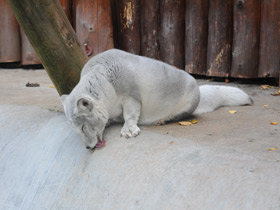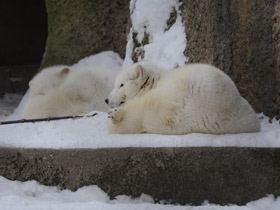The Arctic fox, the white fox, polar fox, or snow fox (Vulpes lagopus)
Arctic Fox видео
The Arctic fox (Vulpes lagopus), also known as the white fox, polar fox, or snow fox, is a small fox that belongs to the family of Canidae, native to the Arctic regions of the Northern Hemisphere and common throughout the Arctic tundra biome. It is well adapted to living in cold environments, and is best known for its thick, warm fur that is also used as camouflage. It has a large and very fluffy tail. In the wild, most individuals do not live past their first year but some exceptional ones survive up to 11 years. Its body length ranges from 46 to 68 cm (18 to 27 in), with a generally rounded body shape to minimize the escape of body heat.
The Arctic fox preys on many small creatures such as lemmings, voles, ringed seal pups, fish, waterfowl, and seabirds. It also eats carrion, berries, seaweed, and insects and other small invertebrates. Arctic foxes form monogamous pairs during the breeding season and they stay together to raise their young in complex underground dens. Occasionally, other family members may assist in raising their young. Natural predators of the Arctic fox are golden eagles, Arctic wolves, polar bears, wolverines, red foxes, and grizzly bears.
Appearance and peculiarities
Alopex lagopus is a small animal (body length 45-70 cm, weight 2-8 kg) and looks different depending on the time of year. Its appearance resembles that of a fox. In winter, when its coat is thick and fluffy, it looks stocky and its ears are set wide apart and barely protrude from the coat. In the short summer coat, the fox is rather tall and thin. Its relatively large head appears disproportionate in summer, with huge ears and a blunt muzzle. The arctic fox is the only member of the canid family with pronounced seasonal colour dimorphism.
Size
The average head-and-body length of the male is 55 cm (22 in), with a range of 46 to 68 cm (18 to 27 in), while the female averages 52 cm (20 in) with a range of 41 to 55 cm (16 to 22 in). In some regions, no difference in size is seen between males and females. The tail is about 30 cm (12 in) long in both sexes. The height at the shoulder is 25 to 30 cm (9.8 to 11.8 in). On average males weigh 3.5 kg (7.7 lb), with a range of 3.2 to 9.4 kg (7.1 to 20.7 lb), while females average 2.9 kg (6.4 lb), with a range of 1.4 to 3.2 kg (3.1 to 7.1 lb).
Nutrition
This northern raptor eats all types of prey it can catch. On the continental tundra, small rodents, mainly lemmings, predominate in its diet throughout the year, as well as birds. On the coast, Arctic foxes feed on fish and marine debris, and a large proportion of their diet consists of carrion. They often accompany polar bears and obtain some of the meat from the seals they kill. Arctic foxes also feed on trapped animals, making no exceptions even for other arctic foxes. In total, their diet consists of 125 animal species and 25 plant species, including blueberries and blackberries, grasses and seaweed. In summer, the foxes store excess food for the winter: they stuff lemmings and captured fish into crevices between rocks and bury them in the ground, ramming the hole with their noses and paws. During the summer, a layer of fat accumulates under the skin of these animals, which protects them from the winter cold and serves as an energy store. The fat is gradually consumed during the winter, so that in spring the fox loses up to a third of its autumn weight.
Social behaviour and habitat
Arctic foxes tend to inhabit open tundra with rough terrain. They dig burrows in sandy hills and coastal terraces, and complex underground labyrinths with many entrances (up to 60-80). As a rule, these animals are monogamous, although polygamy is sometimes observed (on the Commander Islands).
A typical fox family consists of a male, a female, the young females from the previous litter and the current year's cubs. Families usually live separately, but may settle in colonies of 2-3 families. The size of an arctic fox family ranges from 2 to 30 km2. Arctic foxes spend much of the year roaming in search of food. During the breeding season, arctic foxes return to the areas from which they migrated in autumn and winter, occupying old dens or digging new ones.
Taxonomy
Vulpes lagopus is a 'true fox' belonging to the genus Vulpes of the fox tribe Vulpini, which consists of 12 extant species. It is classified under the subfamily Caninae of the canid family Canidae. Although it has previously been assigned to its own monotypic genus Alopex, recent genetic evidence now places it in the genus Vulpes along with the majority of other foxes.
Subspecies
- Mednovsky's arctic fox (Alopex lagopus semenovi);
- Svalbard arctic fox (Vulpes lagopus spitzbergenensis);
- Greenland Arctic fox (Alopex lagopus groenlandicus);
- Bering Islands arctic fox, Alopex lagopus beringensis;
- Icelandic arctic fox, Alopex lagopus fuliginosus;
- Pribilof Islands Arctic fox, Alopex lagopus pribilofensis;
- Greenland Arctic fox, Alopex lagopus foragorapusis;
- Alopex lagopus hallensis, Alopex lagopus hallensis;
- Alopex lagopus innuitus;
- Alopex lagopus sibiricus;
- Alopex lagopus ungava.












































